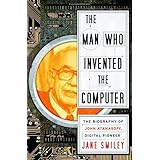
Average Reviews:

(More customer reviews)Jane Smiley's new book is a biography of John Atanasoff, The Man Who Invented the Computer. In this slim volume (219 pages), she attempts to present the life of Atanasoff as well as a number of other contemporaries, describe the machine that he built as well as several other computers, and explore the ENIAC patent trial in 1971. Such an undertaking requires an author with expertise in historical research, physics and electrical engineering, as well as patent law. Unfortunately, Ms. Smiley is an adept writer of fiction.
In addition to a description of Atanasoff's life, the author diffuses her limited effort by including a cast of characters, such as Alan Turing, Konrad Zuse, Thomas Flowers, John von Neumann, John Mauchly and J. Presper Eckert. The bibliography indicates that Ms. Smiley has relied on a remarkably limited number of exclusively secondary or lesser sources. The result is a derivative text that reads more like a college term paper than a serious historical effort.
Ms. Smiley's comprehension of science also appears to be quite limited. She describes quantum mechanics only as "...the science that predicts what happens in systems..." Why mention quantum mechanics at all if this is the best explanation that can be provided? Furthermore, she appears confused at times on the concepts of "analog" and "digital," and seems enamored of the novelty of the binary system, which was actually described more than two thousand years ago, and has been known in its modern form for the last 300 years.
Perhaps the most significant criticism is the lack of clear definition of the terms and concepts that form the basis of the work. The word "computer" has been used over the years to describe both human beings and a broad range of devices from the abacus and slide rule to the Cray Supercomputer. While these uses of the concept may be linked by a "family resemblance," a much more specific definition of the term must be employed if one uses the unique identifier: "the" computer. What are the key characteristics that made the ABC machine the significant break in history that led directly to the modern development of the computer? In fact, the machine that Smiley describes was a modest effort to address a single problem. While there were electronic components, it continued to need human input and control, limiting it to functioning at "human," rather than "electronic" speed. While Smiley states categorically that the machine "worked," this claim is hardly universally accepted. The intermediate storage mechanism was unreliable, and there were problems with both input and output devices. Even the replica made 30 years later fell far short of the identified goal of solving equations with 29 variables.
A critical question remains unaddressed: if the ABC represented a significant advance, a useful machine successfully solving a significant problem, why did no one else see its utility? Why did it sit collecting dust in a basement in Ames until it was eventually scrapped?
Ms. Smiley relies solely on the decision of Judge Larson in 1973 in her attempt to depose ENIAC from its generally acknowledged place as the first computer. She states simply that "...Sperry never appealed the decision, and so they must have accepted it." This is a simplistic and hopelessly naïve viewpoint. Legal decisions result from an adversarial system, where winning, not the ultimate truth, is the established goal. Judge Larson may have been a legal expert, but he knew nothing of the science the competing claims except what was presented in court, and various writers over the years have challenged how much of what was presented he read or understood. A better case than that will have to be presented to replace the first completely electronic, high speed, fully programmable multipurpose computer used successfully to compute firing tables and solve problems related to the hydrogen bomb with a questionably functional dust collector.
In short, this brief effort is no more than a rehash of previously advanced theories, devoid of original research or fresh insight. The advice to "write what you know" is an old cliché, which unfortunately was ignored in this case. Prolific authors occasionally write things that prove embarrassing and publishers sometimes print junk just because of the author's stature. Neither phenomenon is unique to this book, but both are evident. This book rightfully deserves an early trip to the remainder bin.
Click Here to see more reviews about: The Man Who Invented the Computer: The Biography of John Atanasoff, Digital Pioneer

0 comments:
Post a Comment